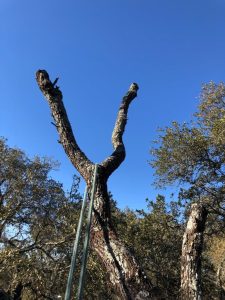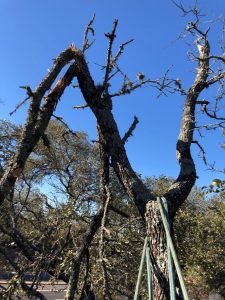Texas was hammered again by severe winter weather on February 1st and 2nd 2023. Unlike the more statewide “Snowmageddon” of 2021, this time the tree damage was not as widespread. Based on state disaster declarations, the worst of the damage occurred in 23 counties, including all of central Texas and extending intermittently northeast to the OK-AR border. In 2021, damage was mostly from freeze rather than breakage. This time the amount of limb and tree breakage was far worse in the Austin area, necessitating a more urgent clean-up response, versus the more gradual clean-up that occurred in 2021 as we waited to see what trees had survived.
Due to temps hovering right around freezing for two days, with a slow constant drizzle, central Texas had ice thicknesses up to three quarters of an inch. Countless limbs snapped throughout the day on February 1, and even more failed on the second as more ice accumulated. Although weather persons in Austin referred to it as the “worst ice storm since 2007” this oft-made statement left many a seasoned arborist around here scratching their heads. In 43 years of doing tree work in central Texas, I’ve never seen ice storm damage that came close.
According to Texas electric utility reps, half an inch of ice is right around the breaking point, literally, for trees. This of course depends on the species, and evergreens like live oak, Ashe juniper and TX mountain laurel were the worst hit in Central Texas. Based on my observations, cedar elm was the hardest hit deciduous species, with Arizona ash, red oak and crepe myrtle damage also common. Strangely, “self-pruning” pecans (don’t you love that term?) barely lost a twig, from what I saw.
Most of my clients rarely see storm damage, whether it be from ice or wind. This is of course because well maintained trees statistically experience far less storm damage. However, the severity of this event was exceptional in that even perfectly managed trees suffered extensive damage. My observations were that larger broken limbs (bigger than about 7 inches diameter) almost always had some decay which was almost always visibly associated with an old pruning wound. So it is vital to remember that pruning does cause injury, and especially if it is not done properly, that injury can lead to decay and failure years later.
So how should ice-damaged trees be cared for? As soon as possible after the ice melts, completely broken branches, especially larger and/or longer ones, should be cut right below the damaged area (see pictures below). The reasoning for this is that with species likely to resprout, I believe it is better to leave these stubs, with the intention of doing some restoration pruning in the future. Also, the cleanly cut end reduces the surface area for decay. If these broken limbs are cut all the way back to a sizeable fork, then there’s a possibly permanent “hole” in that part of the canopy, as well as a possibly quite large pruning wound, which, even if made perfectly, is not likely to close over for decades on a mature tree. For species unlikely to sprout from large stubs, like junipers, these branches should be cut back to a fork.

Broken limbs after remediative pruning

live oak limbs broken by 2/3 inch of ice
Now that we have reached bud break and are starting to see buds emerge near these broken stubs, it may be best to leave completely broken stubs alone. If too much of the diameter of the branch tore off, it may be best to cut off the most badly damaged area while trying to preserve as many of those buds or sprouts as possible. This is really a judgment call best left to an experienced arborist.
Of course the big question in central Texas is always, “What about oak wilt?” With the recommendation from the joint task force I chaired in 2012 (see my oak wilt page) being to avoid pruning oaks beginning February 1, the question is what will the impact of the storm and subsequent pruning be in regards to oak wilt? The good news is that due to the cold weather that persisted for a few days after the storm, the probability of oaks becoming infected during that time was pretty much nil. Too cold for flying insects, and with the drought we’ve had, fungal spores have been far less common. And the accepted theory is that after about three days, exposed live tissue on an oak is no longer a viable infection point for oak wilt. So the wounds on branches that completely broke off within those first few days were extremely unlikely to be infection courts and so painting was not necessary, unless of course the torn ends were cut off afterwards.
But what about the countless cracked/ hanging limbs still out there? As the weather warms up, and many of these then break off, new tissue is exposed, and the risk of oak wilt theoretically increases. These limbs obviously need to be removed for safety reasons. How far to cut them back is again best determine by a competent, qualified arborist. Immediate painting is recommended on all wounds on oaks that expose live tissue. One problem with many less skilled and/or less scrupulous tree services in Austin is that they often only paint oak wounds after they’ve finished cutting on an entire tree (if they do it at all), sometimes hours later. This leaves the tree vulnerable during that time, but more importantly leads to many (if not most) of the wounds being missed. Many of the services doing this are also doing all the actual pruning from the ground, which leads to a very large percentage of the cuts being made very poorly and injuriously. For more info see my pruning pages and posts.
